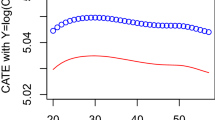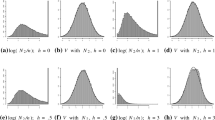Abstract
In this paper, the estimation of average treatment effects is considered when we have the model information of the conditional mean and conditional variance for the responses given the covariates. The quasi-likelihood method adapted to treatment effects data is developed to estimate the parameters in the conditional mean and conditional variance models. Based on the model information, we define three estimators by imputation, regression and inverse probability weighted methods. All the estimators are shown asymptotically normal. Our simulation results show that by using the model information, the substantial efficiency gains are obtained which are comparable with the existing estimators.
Similar content being viewed by others
References
Cochran W G, Rubin D B. Controlling bias in observational studies: a review. Sankhy, 35: 417–446 (1973)
Rosenbaum P R. Observational Studies. New York: Springer-Verlag, 1995
Hahn J. On the role of the propensity score in efficient semiparametric estimation of average treatment effects. Econometrica, 66: 315–332 (1998)
Cheng P E. Nonparametric estimation of mean functionals with data missing at random. J Amer Statist Assoc, 89: 81–87 (1994)
Hirano K, Imbens G W, Ridder, G. Efficient estimation of average treatment effects using the estimated propensity score. Econometrica, 71: 1161–1189 (2003)
Matloff N S. Use of regression functions for improved estimation of means. Biometrika, 68: 685–689 (1981)
McCullagh P, Nelder J. Generalized Linear Models. London: Chapman and Hall, 1989
Carroll R J, Fan J, Gijbels I, et al. Generalized partially linear single-index models. J Amer Statist Assoc, 92: 477–489 (1997).
Heyde C C. Quasi-likelihood and Its Applications. New York: Springer, 1997
Rubin D B. Bayesian inference for causal effects: the role of randomization. Annals of Statistics, 7: 34–58 (1978)
Rosenbaum P R, Rubin D B. The central role of the propensity score in observational studies for causal effects. Biometrika, 70: 41–55 (1983)
Alberto A, Imbens G. Large sample properties of matching estimators for average treatment effects. Econometrica, 74: 235–267 (2006)
Wang Q H, Rao J N K. Empirical likelihood-based inference under imputation for missing response data. Annals of Statistics, 30: 345–358 (2002)
Wang Q H, Lindon O, Härdle W. Semiparametric regression analysis with missing response at random. J Amer Statist Assoc, 99: 334–345 (2004)
Foutz R V. On the unique consistent solution to likelihood equations. J Amer Statist Assoc, 72: 147–148 (1977)
Author information
Authors and Affiliations
Rights and permissions
About this article
Cite this article
Sun, Zh. Quasi-likelihood estimation of average treatment effects based on model information. SCI CHINA SER A 50, 1–12 (2007). https://doi.org/10.1007/s11425-007-2046-4
Received:
Accepted:
Issue Date:
DOI: https://doi.org/10.1007/s11425-007-2046-4
Keywords
- average treatment effects
- inverse probability weighted quasi-likelihood
- unconfounded assignment treatment
- model information




